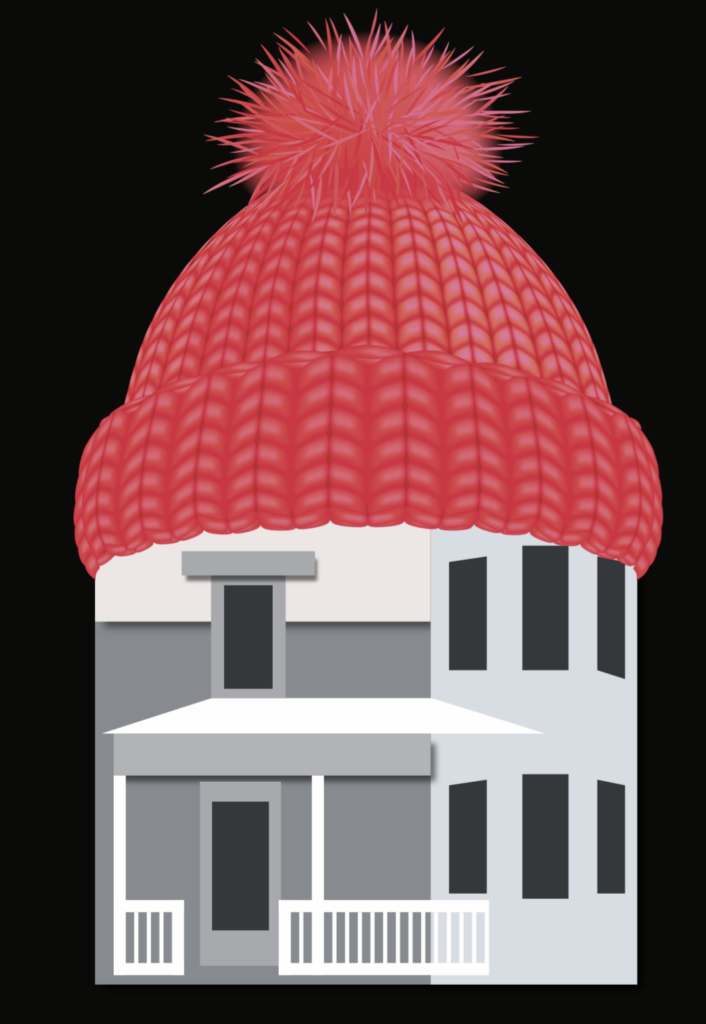
WHO IS COMFORT HOME INSULATION & ROOFING?
Welcome to Comfort Home Insulation & Roofing, your trusted partner in fortifying your property against the elements with top-of-the-line insulation and roofing solutions. With a steadfast commitment to excellence and innovation, we specialize in creating spaces that prioritize comfort, energy efficiency, and durability.
At Comfort Home Insulation & Roofing, we blend expertise with passion to deliver unmatched results. With years of industry experience, our team of skilled professionals stands ready to tackle projects of any scale, from residential homes to commercial complexes. We pride ourselves on our meticulous attention to detail, unwavering dedication to quality, and relentless pursuit of customer satisfaction.
H
DO YOU KNOW HOW MUCH HEAT YOU ARE LOSING?


WHAT WE DO
MATERIAL OPTIONS
CELLULOSE
Go Green
FIBERGLASS
Cost-Effective
A worthwhile investment that lasts for many years to come!
HELPFUL INFORMATION
Installation time depends on the size of the home; usually it’s a one-day job. Even with bigger homes we will be able to insulate your home in just a couple of days, depending of course on the size of your home. Our professional crews are trained to treat your home with the utmost respect and care while causing you the least inconvenience possible.
- Quite likely. A properly insulated home which is environmentally safe, fire resistant, and a continued high R value would be a valuable benefit in the future. And lower utility bills are always an attractive feature to a buyer.rcent
Fiberglass is made from molten sand or recycled glass and other inorganic materials under highly controlled conditions. Fiberglass is produced in batt, blanket, and loose-fill forms.
Rock and slag wool are manufactured similarly to fiberglass, but use natural rock and blast furnace slag as its raw material. Typical forms are loose-fill, blanket, or board types.
Cellulose is a loose-fill made from paper to which flame retardants are added.
Re-insulating your home provides all the benefits mentioned before – higher energy efficiency, lower monthly bills, more comfortable home, etc. You probably need to re-insulate your home if it was built in the 19070s or earlier. When considering whether to install more insulation, look out for:
- Higher than normal energy bills
- Drafty rooms
- Uneven temperatures from room to room
- Air conditioning running more than normal during the summer
- Ice dams in the winter
Insulation helps keep outdoor air from getting inside your home and conditioned indoor air from escaping. This is achieved by trapping pockets of air and slowing down the in/out process. In winter, heat flows directly from all heated living spaces to adjacent unheated attics, garages, basements, and even to the outdoors, heat flow can also move indirectly through interior ceilings, walls, and floors — wherever there is a difference in temperature. During the cooling season, heat flows from the outdoors to the interior of a house. A wool sweater will keep you warm if the wind is not blowing and it is not raining. On a windy, rainy day, wearing a nylon shell over your wool sweater helps keep you reasonably dry and warm. A house is similar, on the outside, underneath the brick or siding, there is an air barrier that does the same thing as the nylon — it keeps the wind from blowing through. Then there is the insulation (like your sweater) and a vapour barrier, which helps keep moisture away from the house structure where it can do damage.
Proper insulation is vital when it comes to having a healthy comfortable home. Apart from keeping your energy bills low, they prevent mould growth and also keep out unwanted noise. We recommend R-Values of 60 in the attic for maximum savings and comfort. Proper insulation in attics helps prevent warm air from escaping through celling and forming moisture. When warm air hits a cold surface in your attic, condensation occurs causing frost or water damage, that results in the growth of mould and mildew, which is a health hazard and damages your attic. Well-insulated attics help keep the indoor temperature in balance and prevent moisture buildup, better sound-proofing and better air quality inside your home. According to statistics, the adequately insulated home can reduce heating and cooling costs between 20% – 50%.
It’s essential that insulation in your attic is installed with the right R-Value. Insulation in your attic helps provide resistance to heat/cold flow reducing your cooling and heating costs. Your insulation’s ability to resist the transfer of heat/cold is measured by R-Value. Meaning, the higher an insulation’s R-value, the better the ability to withstand the flow of heat or cold. It is important to note that the R-Values are not directly related to the thickness of the insulation, but it is however compared to the number of fibres per square inch or the density of insulation. So if your home is over 25 years old and insulation in your attic has never been updated the likelihood that your R-Value between 15 – 30 is very high since insulation materials settle over time. Moreover, if your house built in the early ’70s, it might have a little bit of insulation in the attic or even empty cavities between the joists. Therefore you would need to bring it to today’s’ standards by adding the top-up layer of blown in insulation.
Your heating and cooling system accounts for the highest percentage of your energy bills so losing heat directly translates to higher energy costs. The average home may be losing up to 30% of its heat if not properly insulated. Insulation helps to improve efficiency, keep a comfortable indoor temperature and saves significant costs on energy over the long term.
Generally speaking, some of the most common places in the house where heat may be escaping include;
Cracks in Walls, Doors and Windows
Drafts account for up to 38-percent of heat loss in a home. Gaps in the doors, windows and walls let cool air into the house. Inspect these areas for worn weather-stripping and seal any cracks less than 1.4 inches wide with caulk. Use insulation foam for larger cracks. Taking care of these drafts alone can make a significant difference in your energy efficiency.
Basement Walls and Floors
Although very little heat is lost through your basement floor (typically less than 1-percent) you may be losing up to 20-percent of your home’s heat via the basement walls. Insulating the walls will help to curb this heat loss. Unfinished basements are particularly notorious for losing heat.
Frame Walls
Frame walls lose heat through conduction where the warm air escapes through the walls. This heat transfer accounts for up to 17-percent of the home’s heat loss. This scenario points to insufficient wall insulation which you can confirm by removing the wall power outlet and inspecting the condition of the insulation of any. Be sure to turn off power to the outlet before the inspection.
Blown in insulation can easily be installed in existing walls so upgrading your wall insulation isn’t a major or invasive project as it used to be in the past. Be sure to get the insulation professionally done for the most energy savings and return on investment over the long-term. Attic Insulation Toronto is happy to make recommendations about the best type of wall insulation for your home.
Windows
Apart from gaps around your doors and windows, glass windows are notorious for losing heat. If you have noticed it is colder at the window despite it being closed, it is because glass naturally has poor insulation qualities.
You may choose to replace your old windows with more modern Energy Star rated versions or for the budget conscious, install plastic sheets designed specifically to keep heat inside the house by reflecting it indoors. Both options also prevent heat from entering the house from outside via the glass during the summer so you’ll feel the difference all-year-round. Energy inefficient windows lose up to 16-percent of the home’s heat.
Attic Holes
Holes that accommodate ducts, pipes and vents lose up to 15-percent of indoor heat. You can expect an even higher percentage if the attic is not properly insulated, to begin with. Warm air rises to the attic from the living space below and out the house through the roof if the attic floor is not properly insulated. Again, this is a job for a professional as DIY attic insulation installation doesn’t give nearly the same result in energy efficiency and ambient temperature that a professional can guarantee.
Chimney
Poorly fitted or missing fireplace dampers allow air to flow freely up and down the chimney and eventually lose valuable heat, up to 14-percent of your home’s heat. Visually inspect for the missing or damaged dampers and replace accordingly. A simple test is to light a small fire and see if the smoke rises in the chimney flue. This is an indication that there is an air leak most likely at the dampers.
Other Areas
Other areas where you might be losing heat include;
- Roof – 20-percent
- Ceiling – 5-percent
- Doors (through conduction) – 5-percent
- Electric outlets – 2-percent
- The age of your home
Insulation is an easy factor to be forgotten and this is why older homes tend to have insufficient or damaged insulation. Some old types of insulation even contain dangerous substances like asbestos. If it’s been 20+ years since your last insulation installation, you must consider to re-insulate your house. Insulations older than 20 years probably don’t have enough insulation to protect your home from exterior temperature and the insulation material used back then, can be consumed or out of shape.
- Water damage
If you had water damage in your home, you will find a lot of hidden damages. One of these damages, especially in the case of a long-time stand of water, is insulation. Water in your home always brings problems – it compresses and damages insulation, making it inefficient and sometimes useless, and it’s the key ingredient in mold growth too. If you are restoring the roof before winter, it is also time to change your insulation.
- Pests
Pests are a really big concern for old insulation. Uninvited guests of the four, six, and eight-legged variety can damage the insulation by going through it and with years of pests among insulation it gets weak and unable to protect your house. Dead pests leave behind something even more unpleasant and unsanitary. If you notice continual sounds, noises or activity in the attic, it’s best to get rid of them and have your insulation assessed as soon as possible.
- High utility bills
One of the biggest complaints that our customers share with us is their heating and cooling bills – and this is a problem that can be greatly reduced by inserting or replacing old insulation. If your insulation is old or damaged, there’s also a lot of air leakage going on in your home, so you end up with high bills.
- Drafts
If your conditioned air is escaping your home, it means that there are drafts, and air can also come INTO your home. This results in hot or cool spots and drafty rooms. Adding insulation to your house often completely eliminates these problems.
When people are cold in their house they think “I need better insulation”. This may be true, but Air Sealing can be as important as or potentially MORE important than insulation. If air is moving through your building, quite often it is coming from outside, so outside conditions are coming inside. Air coming from the outside is called Air Infiltration or Air Leakage. By the way, limiting Air Leakage doesn’t just help in the Winter; it helps in the Summer as well. Air Sealing can be accomplished with a variety of materials and methods. Comfort Home Attic Insulation tends to favor foam sealant. Other materials for Air Sealing include: Window & Door Foam, Caulking, Backer Rod, Weatherstripping, Door Sweeps, etc.
Just like properly sizing your furnace air conditioning unit, you want precisely the right amount of attic ventilation for your home. Poor attic ventilation can ruin your insulation, destroy your shingles, and potentially raise your energy bills. In the summer, natural air flow in a well-vented attic moves super-heated air out of the attic, protecting your roof and removing humidity, which can lead to mold. On the other hand, too much ventilation can expose your home to leaks during inclement weather.
So, how much is adequate ventilation? It is important to talk to a professional to determine the precise amount that your home requires. In general, as per the building code you need a minimum ratio of 1:300, where for every 300 square feet of ceiling space, you need 1 square foot of attic ventilation.
No. Your current insulation does have some insulating qualities and will be taken into consideration when adding more insulation to your attic.
The only time that we would need to remove the old insulation is if there is smoke or water damage.
Five Attic Ventilation Traps to Avoid
WHY WORK WITH US?
OPerated by a woman
Yes. It's a construction business, run by a woman... but I like what I do! I like solving problems and would like to make your home more comfortable and energy efficient!
Honesty
I know how it feels when your final bill is not what you expected because there are so many hidden costs! I don't do that. Everything is very clear, no surprises, with a goal of 100% customer satisfaction.
Discount and Referral
My business - my rules. I offer a seniors discount. I also offer a referral bonus.
I do care
People say, "Business is all about money". While I do run a business, I sincerely care about my customers. No job is too small, I provide quality service no matter what!






